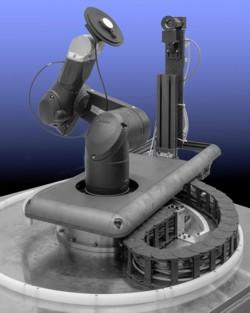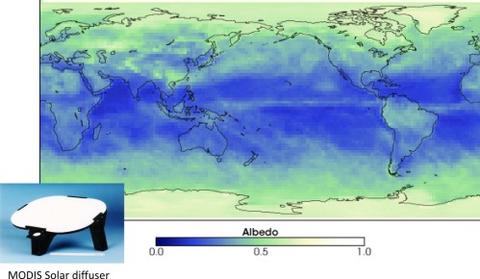Summary
ROSI (Robotic Optical Scattering Instrument) is a new facility for measuring reflectance and scattering of materials in the ultraviolet to short-wave infrared wavelength range (250 nm to 2400 nm). Designed to replace the current reference reflectometer, STARR, ROSI employs advanced technologies, such as high-brightness tunable light sources and a robotic arm goniometer, that will enable reflectance calibrations at out-of-plane geometries and expand NIST's capabilities for reflectance measurements in the short-wave infrared wavelength region. ROSI will provide reference calibrations for white and neutral diffuse reflectors, measurements of scattering and reflectance of materials for databases and model validation, and wavelength-resolved mirror reflectance measurements. ROSI was formerly known as STARR II.
Description

ROSI (Robotic Optical Scattering Instrument)
Have you ever wondered why some objects appear glossy, and others diffuse? Or thought about the complexity of characterizing the way light reflects from an object under different illumination and viewing angles and at different wavelengths in order to realistically render it in a computer simulation?
The characterization of materials for reflectance and scattering as a function of wavelength, polarization, incidence angles, and viewing angles is described by the bidirectional reflectance distribution function, or BRDF. BRDF measurements are needed not only in visible light applications, but also in the ultraviolet and infrared wavelength regions.
For example, to determine the Earth's radiation budget and monitor climate forces, satellites make measurements of the earth's reflectance, or albedo, over the ultraviolet to short-wave infrared reflected solar spectrum using Earth-viewing spectroradiometers. These instruments are periodically calibrated on board the orbiting satellites using a reference reflector called a solar diffuser. During the calibration, the diffuser is brought into the spectroradiometer's field of view to provide a source of known radiance to the spectroradiometer using the sun as a known illumination source and the diffuser as a calibrated reflector.

NIST's current reference reflectometer, STARR, has been in used since the mid-1990s. It provides spectral BRDF, spectral specular reflectance, and spectral directional-hemispherical reflectance factor measurements from the ultraviolet to the short-wave infrared. While the existing facility provides high accuracy, stable measurements, evolving measurement needs and improvements in technology are driving the need for a new spectral reflectance facility.
Among the needs to be addressed by ROSI are:
- Improved sample holding flexibility and unobstructed viewing of the sample surface
- Expansion of BRDF capability in the shortwave infrared region, which is limited in the current STARR facility
- Addition of out-of-plane BRDF measurements, particularly important for the satellite and remote sensing community, which often employs out-of-plane viewing
ROSI makes use of new techniques in light source and goniometer design. A fiber-coupled, high-brightness broadband supercontinuum source has replaced a traditional lamp for the visible to shortwave infrared wavelength range. Because the supercontinuum source can be very efficiently coupled to a monochromator, the tunable source power in ROSI has been shown to be 100 to 1000 times that in STARR.
The higher source power enables a single receiver to be used over the full wavelength range, eliminating the need to exchange and realign detectors for measurements in different parts of the spectrum.
For ultraviolet wavelengths, a high-brightness laser-driven plasma light source is being installed that will enable us to extend the tunable output of ROSI's light source down to a wavelength of 250 nm.
To fulfill the need for out-of-plane scatter measurements, in which the scattering angle is outside of the plane of incidence defined by the incident light and the surface normal, ROSI employs a robotic arm-based goniometer. An industrial robot holds the sample and can tilt and rotate it such that, in combination with the angular motion of the receiver arm about the goniometer center, almost any combination of incident angle and in-plane or out-of-plane viewing angle can be reached. The sample is held from its back face, allowing unobstructed viewing and incident angles. Compensation for samples of different thicknesses and wedge, and spatial scans of the sample surface, are easily implemented in the robot's software.
Major Accomplishments
- Demonstration of multi-angle, hemispherically-scanned BRDF measurements
- Integration of software driving the robot and light source to allow arbitrary spectral, spatial, and angular scans to be carried out
We are currently evaluating the uncertainty budget, integrating the UV light source, and comparing with other NIST instruments.

